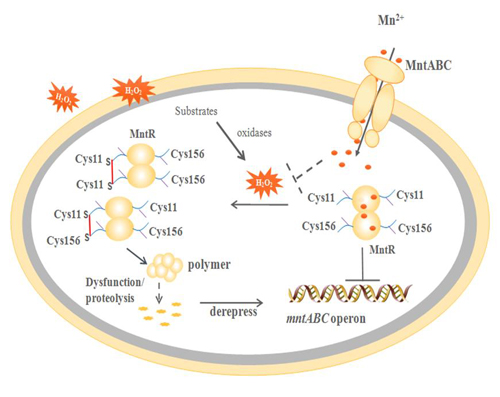Manganese (Mn2+) is essential for organisms in the resistance of oxidative stresses, particularly in catalase-devoid streptococci. The DtxR family metalloregulators, through sensing cellular Mn2+ content, regulate its homeostasis and avoid the cellular toxicity of excess manganese ions. However, how these DtxR-like metalloregulators regulate Mn2+ import by sensing cellular redox status remains unknown.
Prof. DONG Xiuzhu’s group at the State Key Laboratory of Microbial Resources, Institute of Microbiology of Chinese Academy of Sciences, clarifies for the first time the redox regulatory mechanism of a DtxR-like metalloregulator MntR in streptococcus, and reveals MntR functioning as a H2O2 sensor in addition to metalloregulator.
Metalloregulators are unique to prokaryotes. The novel function in controlling anti-oxidative stresses in bacteria revealed in this work would shed light on pathogenic bacteria control or drug designing. The paper has been published online in The Journal of Biological Chemistry.
The metalloregulator MntR is previously believed as a Mn2+ sensor. In this study, researchers found that MntR (So-MntR) also functions as a H2O2 sensor and mediates H2O2 resistance in an oral streptococcus (see the Figure below).
Biochemistry analysis revealed that H2O2 disrupted the association between So-MntR and the Mn2+ transporter mntABC by inducing disulfide-linked dimerization of So-MntR. Site mutagenesis of the key cysteine residues reduced H2O2 damage on So-MntR as well as the protein-DNA association, therefore confirming cysteines being the H2O2-oxidative targets.
H2O2 damage on So-MntR was further verified in vivo. Redox Western blot detected So-MntR oligomers in air-exposed cells, but remarkably decreased upon H2O2 pulsing. The key cysteine residues mutagenesis abolished So-MntR degradation under H2O2 stress, confirming that these cysteines contribute to H2O2-induced oligomerization and degradation of MntR.
The physiological experiments indicated that key cysteine mutagenesis led to decreased mntABC expression, reduced cellular Mn2+ content, and Mn-mediated H2O2 survival, thereby supporting that So-MntR functions as a H2O2 sensor and mediates oxidant defense by controlling Mn2+ transport.
Given the wide distribution of Cys11 in streptococcal DtxR-like metalloregulators, the disclosed redox regulatory function and mechanism of So-MntR can be employed by the DtxR family proteins in bacterial resistance to oxidative stress.
Redox-switches based on the redox-sensitive cysteine thiol groups have been widely utilized by H2O2 sensors in conducting the regulatory functions in response to ROS. The traditional metalloregulator functions as a H2O2 sensor found in this study sheds light on that any protein, including regulatory proteins, carrying redox reactive thiol groups in cysteine or methionine residues can be involved in the regulation of redox reactions.
This work is supported by National Natural Science Foundation of China.

A schematic working model of the streptococcal MntR in response to both Mn2+ and H2O2 (Image by Prof. DONG Xiuzhu’s group)
Contact
Prof. DONG Xiuzhu
Institute of Microbiology, Chinese Academy of Sciences
E-mail: dongxz@im.ac.cn
摘要:Prof. DONG Xiuzhu’s group at the State Key Laboratory of Microbial Resources, Institute of Microbiology, Chinese Academy of Sciences, clarifies for the first time the redox regulatory mechanism of a DtxR-like metalloregulator MntR in streptococcus, and reveals MntR functioning as a H2O2 sensor in addition to metalloregulator. Metalloregulators are unique to prokaryotes; the novel function in controlling anti-oxidative stresses in bacteria revealed in this work would shed light on pathogenic bacteria control or drug designing.
关键词: streptococci; Mn-based H2O2 resistance; metalloregulator MntR; H2O2-induced intermolecular disulfide linkage; redox sensitive thiols
